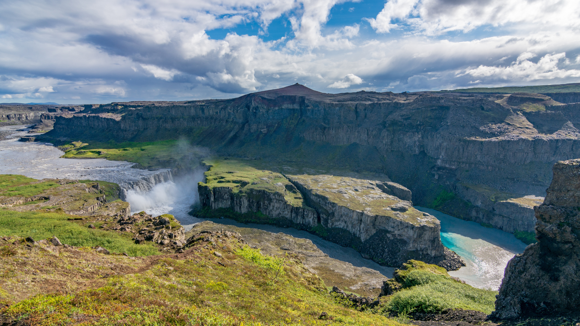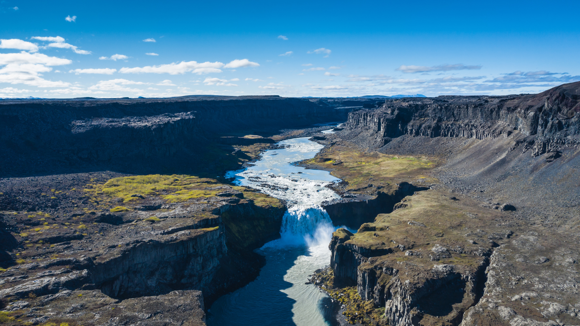Discover Hafragilsfoss Waterfall

There is absolutely no shortage of waterfalls in Iceland, which makes it difficult to know which are truly worth visiting! If you’re on your way or planning to visit Dettifoss or Selfoss, Hafragilsfoss makes for a stunning few-kilometre detour on your journey. And while it’s so close to the more popular waterfalls, you’ll likely find that you can enjoy the power of Hafragilsfoss entirely by yourself.
What Is Hafragilsfoss?
Hafragilsfoss is a pretty waterfall downstream from Dettifoss, a lesser-known attraction within the Jökulságljúfur Canyon. In contrast to Dettifoss and Selfoss, you won’t be able to get as close to the thundering waters, but you’ll still be able to get a sense of the sheer amount of water taking the 30-metre plunge. At 90 metres wide, you can see the waterfall from either side of the river, depending on where you access the location from.
Where is Hafragilsfoss?
Hafragilsfoss waterfall is located on the Jökulsá á Fjöllum River, along with 2 other waterfalls on the same river. The falls are around 2.5km downstream from the more famous Dettifoss waterfall; however, it’s missed on many tours of this region of Iceland. You’ll find the Hafragilsfoss waterfall at the very bottom of Jökulsárgljúfur Canyon, and the tallest cliffs of the canyon make for a breathtaking backdrop.

How To Get To Hafragilsfoss
The most common way people will enter the area is via the Ring Road, or Road 1, from the direction of Lake Mývatn. Immediately after crossing the bridge over the river Jökulsá á Fjöllum, which flows into Hafragilsfoss waterfall, take a left turn onto Road 864 Hólsfjallavegur. Some 30 kilometres on, you’ll find the car park for Hafragilsfoss.
From the Hafragilsfoss car park, the walk to the falls is truly breathtaking, including gorgeous views of the Jökulsárgljúfur Canyon as well as nearby Dettifoss and Selfoss.

Hiking at Hafragilsfoss
With three waterfalls all in close proximity, the area offers a scenic and lesser-known hike. Whether you’re on the East or the West side of the river, the views are beautiful over the canyon. The hike is relatively easy, whichever side of the river you find yourself on, though the route on the West may take you a little longer in distance. This is a there-and-back route, with Dettifoss in the middle, so you see this giant twice.
Best Time to Visit Hafragilsfoss
In harsher weather during winter months, the paths on either side of Hafragilsfoss are closed. You may still be able to see Dettifoss and Selfoss in the area, should you find yourself close by! Always follow signs and never enter roads that are closed due to poor weather conditions.
Most of the year, when you visit Hafragilsfoss, you’re sure to be rewarded with beautiful colours across the canyon. The red craters, green vegetation and steep cliffs of the surrounding canyon make the waterfall one of the most picturesque spots in the area.
Nearby Attractions
Jökulsárgljúfur Canyon and Hafragilsfoss are some of the most photogenic areas of the country. Unfortunately for tourists, however, they are both located in North East Iceland, which is about as far away as you can get from Reykjavik. To make the trip worth it, it’s a good idea to tick off a whole host of nearby attractions.
-
Dettifoss: This is the most powerful waterfall, not just in Iceland, but in the whole of Europe too. The strength with which the water tips over Dettifoss draws a huge number of tourists every year. You can even hike from Hafragilsfoss to Dettifoss if you fancy the adventure.
-
Ásbyrgi Canyon: This horseshoe-shaped canyon is an incredibly popular location for hiking and wildlife watching. Discover a wide range of diverse flora and fauna and learn about the mythological creatures also said to find their homes here.
-
Húsavík: The largest nearby city and the whale-watching capital of Iceland, Húsavík is an exciting place to enjoy a stay in Iceland while learning about the history of the country.
If you’re looking to explore these attractions and more of Northeast Iceland, why not choose the fantastic Fosshotel Húsavík and explore the more remote and off-the-beaten-track areas of the country?